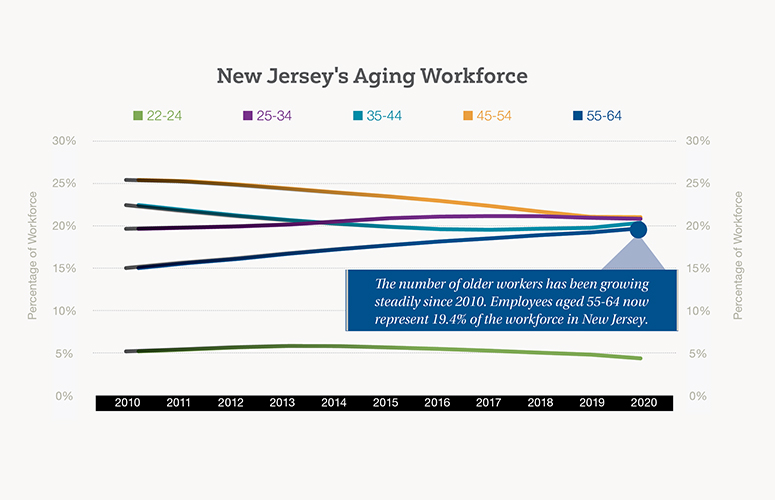Addressing New Jersey’s Aging Workforce
Aging baby boomers, increased life expectancy, and falling birth rates are driving up the average age of the nation’s population, and in turn, its workforce. By 2060, the US Bureau of Labor

Statistics (BLS) projects the share of US workers ages 55 and older will increase from 22.2% to over 26%.
In New Jersey, the share of workers over 55 is growing as well. In 2010, these workers accounted for approximately 20% of the workforce, but that figure rose to nearly 27% in 2020, according to the Census Bureau’s Quarterly Workforce Indicators.
As we think about the future of New Jersey’s workforce and its economy, this demographic trend matters, as an aging workforce presents several challenges. A BLS labor review published in 2020 highlighted how larger, older workforces tend to correlate with higher labor costs, and the eventual retirement of these workers in large numbers represents a significant loss of knowledge and experience, which is difficult to quickly replace.
In New Jersey, some industries are expected to be impacted by these shifts more than others. According to labor market information compiled by the New Jersey Department of Labor (NJDOL), the number of healthcare workers who are 65 and older tripled from 2000 to 2020. Over the same span, the share of the sector’s workforce who are 55 and over increased from roughly 15% to more than 20%.
Similarly, the construction sector’s workforce has been skewing increasingly older as well. From 2000 to 2019, the number of construction workers over 65 nearly doubled, and the number of workers over 55 increased by 151%.
On the other hand, the technology sector has experienced little change since 2014. The share of workers over 45 has stayed roughly the same at 48%, and the share of workers over 65 has increased by just 1.1%.
Focus NJ’s previous Future of Work studies have highlighted a number of tremendous opportunities in these and other industries thanks to increased demand and the adoption of new technologies. Still, ensuring the continued success of industries with an aging workforce will mean getting young people excited about these careers and into the training they need to be successful.
This content was published in the April 2022 Edition of the NJ Business Magazine.





